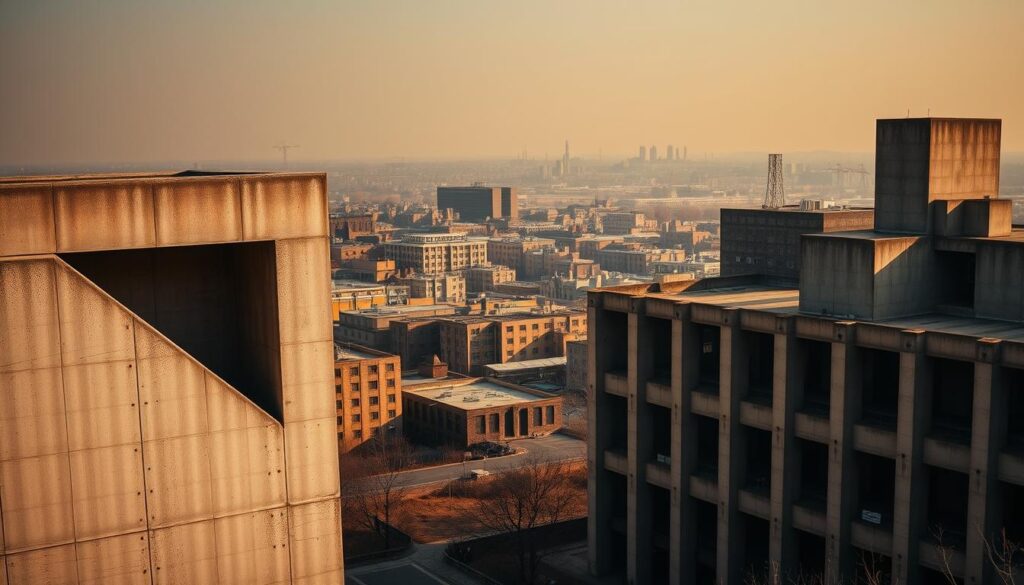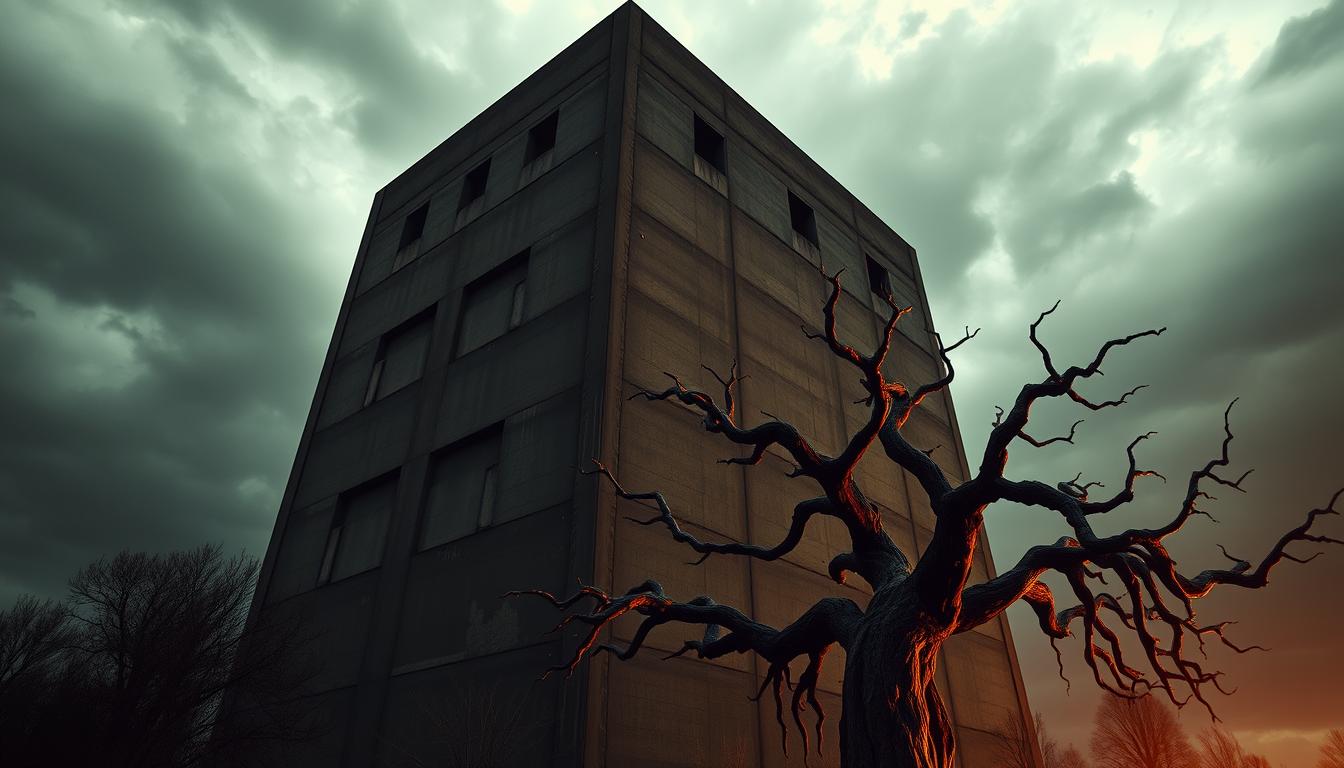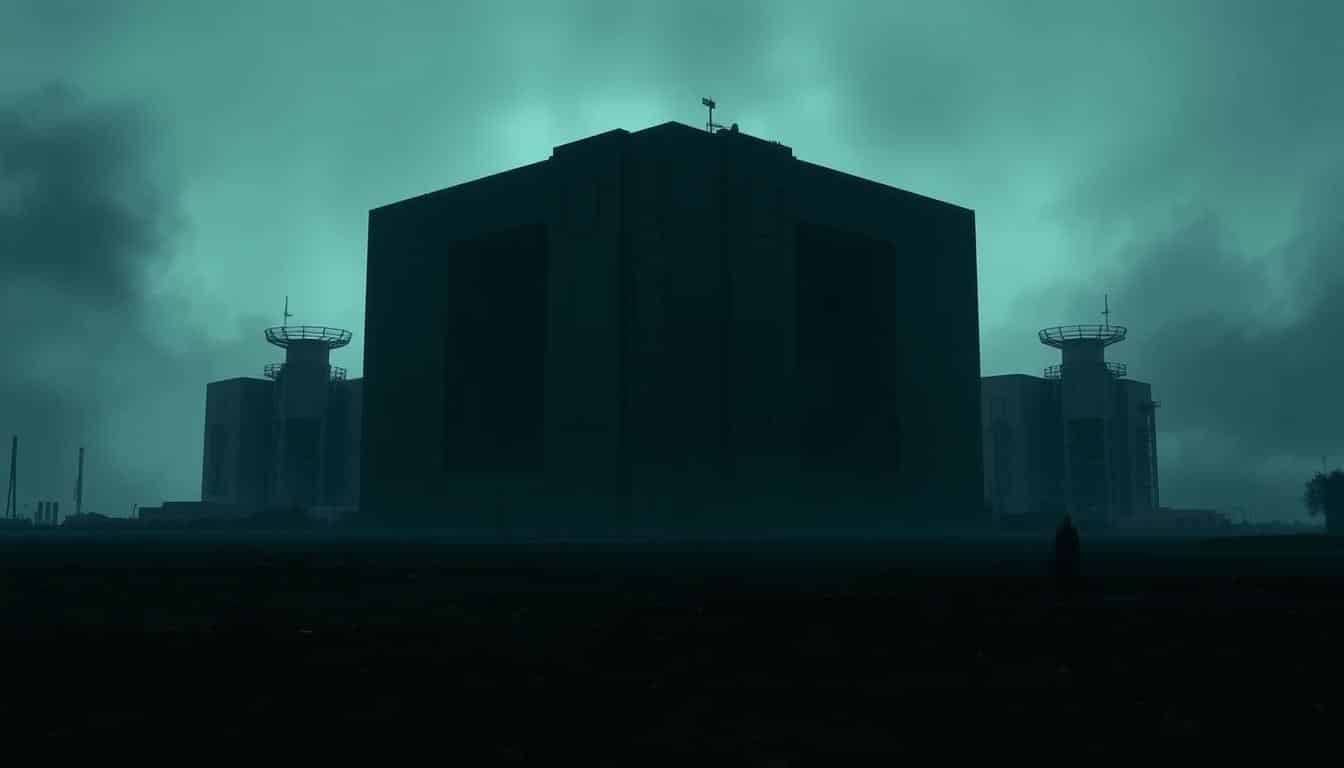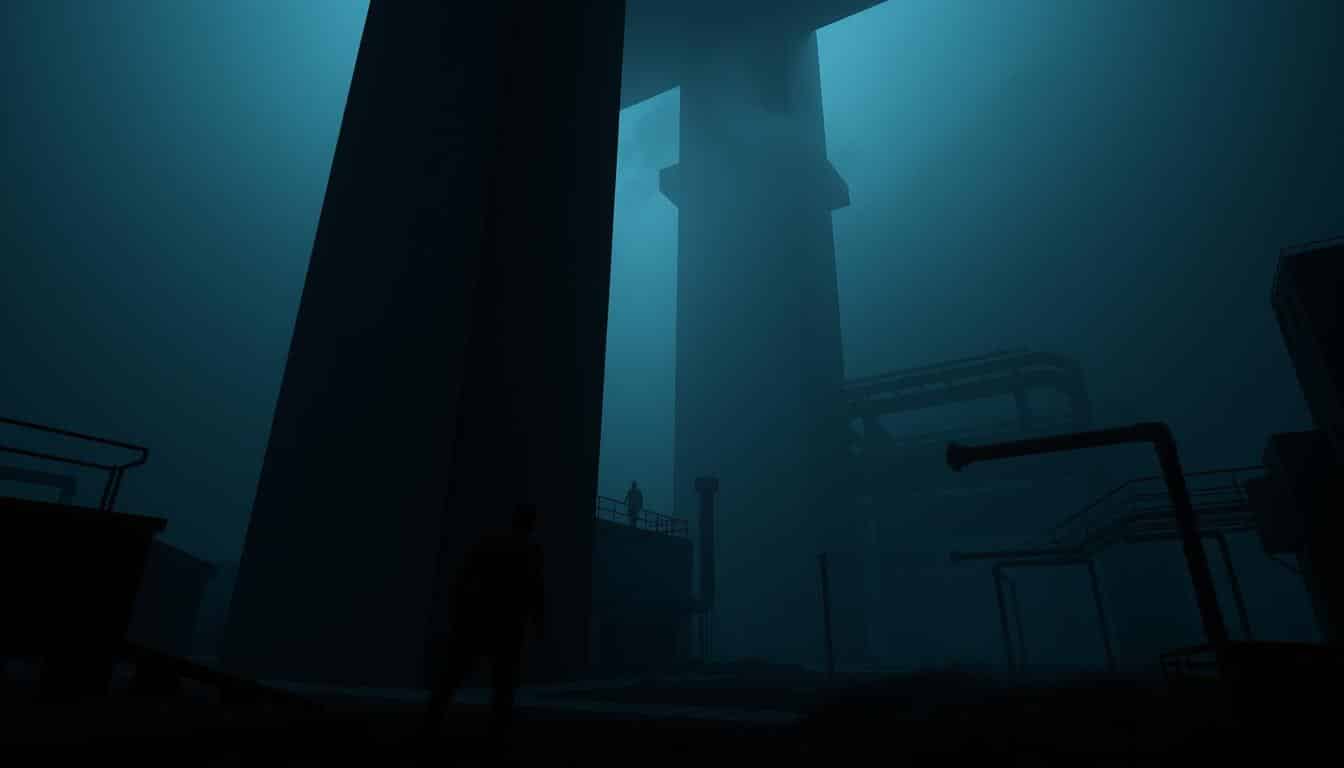Brutalist architecture has a unique charm. It stands out by showing a bold contrast in looks and feelings. The raw, practical designs feature a lot of exposed concrete. This style can make people feel both amazed and uneasy.
In virtual worlds, game developers are starting to use these design ideas more and more. They create spaces that look different from typical games. As players move through these stark yet intriguing places, they go on an emotional trip. The trip is shaped by the architectural choices in the game.
This journey dives into how Brutalist architecture changes not just game visuals, but the whole experience. It shows how deep it impacts player engagement.
Introduction to Brutalist Architecture
Brutalism came to life after World War II. It was a way to meet society’s need for function and chasing social dreams. This style stands out for its concrete look, showcasing raw materials and large bold shapes. It tells the story of its tight bond with city building trends from the 1950s to the 1970s. This was a time when people wanted to show progress through design.
People have mixed feelings about Brutalist architecture. While some admire its stark beauty and strength, others find it too cold and unwelcoming. This split view affects how Brutalist buildings fit into city scenes and their role in today’s digital world. By showing cultural desires and goals with its strong looks, Brutalism still has a big impact online and offline.

The Evolution of Brutalism in Digital Design
Brutalism has become a key style in video games, offering a bold look. This style makes game worlds more dramatic and engaging. Game makers use old and new Brutalist designs to add depth that players feel.
Games show off Brutalism by using raw materials and simple shapes. New tech lets game designers create detailed and big structures. This mix of old styles and new ideas makes games more immersive, reflecting real-life struggles.
Emotional Impact: The Dark Allure of Brutalist Architecture in Virtual Worlds
Brutalist architecture shapes the feelings we get in virtual worlds. It makes gaming environments more engaging by stirring up strong emotions like loneliness or tension. Game makers use this style to pull players into the story and keep them feeling connected. Players find the mix of big spaces and building design deeply moving.
Creating Immersive Atmospheres
Brutalist buildings create engulfing spaces where players are surrounded by the game. The simple look of concrete emphasizes a feeling of danger, making the game more emotional. Designers, such as Moshe Linke, use these big buildings to make spaces that push players to face fears while overcoming game challenges. This makes the game’s setting influence how we play and the story, adding to the game’s impact.
Utilizing Scale and Space
The big size of brutalist buildings brings an extra twist to virtual adventures. These huge structures can make players feel small and vulnerable. This clever use of space draws players into the game world, urging them to explore and connect more. With the massive nature of brutalist architecture, games turn into real experiences. Players feel a strong bond with the game world that lasts.
Case Studies: Notable Games Featuring Brutalist Architecture
Studying games shows how Brutalist architecture creates strong feelings. This style changes how players feel and interact with the game. We’re looking at three key games that show this effect.
NaissanceE and Its Monumental Aesthetics
NaissanceE is a prime example of Brutalist impact. When you play, you move through a huge, concrete world. It makes you feel alone and unsure, which is exactly what the creator, Mavros Sedeño, wanted. The game sticks with you because of these intense feelings.
Control: Exploring Themes of Authority and Control
Control really stands out for its Brutalist settings. The game’s big, bold buildings tie in with ideas of power. As you explore the Federal Bureau of Control, you see how the setting matches the game’s story. This makes the game’s story and feelings even stronger for players.
Fugue in Void: A Romantic Perspective
Fugue in Void offers a different view of Brutalist style, mixing in romance. It takes you to a lonely but stunning world. This mix makes players think deeply about isolation and finding beauty in tough places. The way it connects design with player feelings makes it important to study.
Architectural Influence on Game Development
Brutalist structures inspire game development by shaping the visual and story depth. Their bold shapes and raw materials get woven into digital worlds. This makes games more immersive for players, triggering deep feelings with its grand designs.
Using Brutalism helps tell stories of isolation, authority, and the human condition. Games feel more real and engaging by drawing on these architectural features. The focus on functionality in Brutalist designs matches with how players interact in games.
There’s a growing interest in Brutalist architecture and its role in cities. Games that include these elements offer more than fun. They encourage players to think about their environment and their place within it.
Psychological Effects of Brutalist Structures in Gaming
Brutalist architecture impacts players deeply in video games. These designs shape how players feel, especially feelings of being alone. Big, simple buildings pull players into large, lonely worlds. This makes the game’s emotional journey stronger.
Heightened Feelings of Alienation
Players walking through big concrete areas feel alone. This mirrors their real-life feelings of being solo. They connect deeply with the game’s buildings. These surroundings make players think deeply, feeling very isolated. This isolation affects how they see their story and interact in the game.
Players’ Reactions to Monolithic Designs
The big size and simple look of Brutalist structures cause different reactions. Some players love the bold, raw look, while others feel uneasy or disconnected. This shows the wide impact these designs have on players. The architecture shapes how players feel during the game. Every sharp corner and empty space adds to their experience.
The Role of Sound in Brutalist Digital Spaces
In gaming, sound design is key for memorable experiences. Brutalist digital places offer a special setting for immersive sounds. Here, developers can make the environment more interactive and engaging.
Creating Unique Soundscapes
The echoes and spaces in Brutalist architecture make game sounds stand out. These environments bring sounds to life in a way that grabs players. Developers use sounds like:
- Echoing footsteps in concrete halls
- Ambient noises that show the area’s mood
- Layers of sound that touch emotions
By adding these sounds, the game’s architecture feels more real. This makes the game experience better.
Interaction Between Environment and Gameplay
Game sounds make players feel part of the world. They link game actions with sounds, making everything more dynamic. This leads to:
- Games feeling more real.
- Players paying more attention to their surroundings.
- A stronger emotional bond with the game.
This mix of sound and play keeps players drawn in. They explore Brutalist spaces with more emotion and awareness.
The Human Aspect: Context and Interpretation of Brutalism
Brutalism came to be from mixing socio-political trends. This makes knowing its history key to understanding its importance in culture. This style shows both the dreams and the failures of modern society. Game creators use these ideas to make stories that catch players’ attention. They use Brutalism to show city life that impacts how people live.
A Reflection of Society and History
Brutalism deeply connects to the social issues of its time. It often stands for the fight between moving forward and falling apart. It looks at city life in two ways: good and bad. Game makers use this background to make worlds that push players to think about social problems. Brutalism helps them delve into stories about:
- How urban planning affects people
- Changing public spaces and who can use them
- How building designs reflect past wrongs
The Dichotomy of Beauty and Oppression
Brutalism shows a mix of attraction and harshness. Its simple, strong look can seem beautiful but also has ties to harsh rule. This mix creates a chance for gamers to think as they explore these settings. Brutalism’s big impact is in how it makes us question. This challenges us and starts conversations about:
- Power in public areas
- What society thinks is pretty
- How bold buildings make us feel
Future Trends in Virtual Brutalist Aesthetics
The gaming world is shifting towards the bold look of digital Brutalism. Developers are mixing new trends to change how we play and feel. We will see game designs that push limits and touch our hearts deeply.
New technologies, like virtual and augmented reality, will change how we see game spaces. Players might explore huge, bold buildings that make them feel alone or powerful. These places will be key in telling stories, mixing feelings from Brutalism with the game’s action.
Games are getting deeper stories that talk about power and being human. Digital Brutalism will make these stories more intense. Players will face new challenges that make them think differently about themselves and their surroundings.
Conclusion
Exploring Brutalist architecture in virtual worlds highlights its impact on gaming and Brutalism. Game developers use this style’s unique look and themes, leading to immersive experiences. These experiences stir up emotions, like feeling lost or curious.
This evolution shapes how games look and deepens the player’s connection to the game world. Brutalist elements in games provide a backdrop for storytelling. This lets stories unfold in ways that touch on our history and society. The decisions made in designing these spaces affect how players see and engage with the game.
The relationship between architecture and gaming shows how important design is to cultural stories. The buildings in these games reflect our history and hint at future creative possibilities. The more games feature Brutalism, the more we see its potential to delve into human experiences and emotions.



